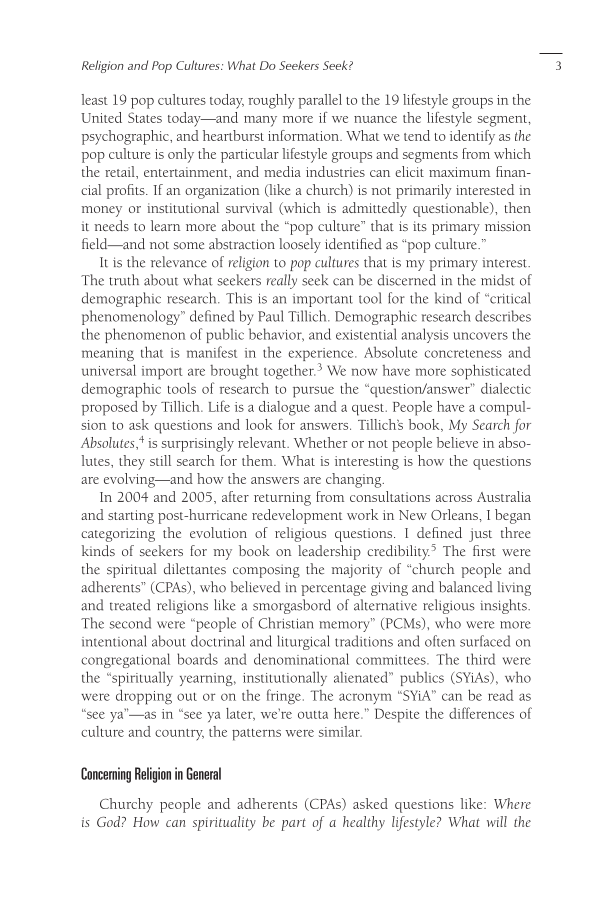Religion and Pop Cultures: What Do Seekers Seek? 3 least 19 pop cultures today, roughly parallel to the 19 lifestyle groups in the United States today—and many more if we nuance the lifestyle segment, psychographic, and heartburst information. What we tend to identify as the pop culture is only the particular lifestyle groups and segments from which the retail, entertainment, and media industries can elicit maximum finan- cial profits. If an organization (like a church) is not primarily interested in money or institutional survival (which is admittedly questionable), then it needs to learn more about the “pop culture” that is its primary mission field—and not some abstraction loosely identified as “pop culture.” It is the relevance of religion to pop cultures that is my primary interest. The truth about what seekers really seek can be discerned in the midst of demographic research. This is an important tool for the kind of “critical phenomenology” defined by Paul Tillich. Demographic research describes the phenomenon of public behavior, and existential analysis uncovers the meaning that is manifest in the experience. Absolute concreteness and universal import are brought together.3 We now have more sophisticated demographic tools of research to pursue the “question/answer” dialectic proposed by Tillich. Life is a dialogue and a quest. People have a compul- sion to ask questions and look for answers. Tillich’s book, My Search for Absolutes,4 is surprisingly relevant. Whether or not people believe in abso- lutes, they still search for them. What is interesting is how the questions are evolving—and how the answers are changing. In 2004 and 2005, after returning from consultations across Australia and starting post-hurricane redevelopment work in New Orleans, I began categorizing the evolution of religious questions. I defined just three kinds of seekers for my book on leadership credibility.5 The first were the spiritual dilettantes composing the majority of “church people and adherents” (CPAs), who believed in percentage giving and balanced living and treated religions like a smorgasbord of alternative religious insights. The second were “people of Christian memory” (PCMs), who were more intentional about doctrinal and liturgical traditions and often surfaced on congregational boards and denominational committees. The third were the “spiritually yearning, institutionally alienated” publics (SYiAs), who were dropping out or on the fringe. The acronym “SYiA” can be read as “see ya”—as in “see ya later, we’re outta here.” Despite the differences of culture and country, the patterns were similar. Concerning Religion in General Churchy people and adherents (CPAs) asked questions like: Where is God? How can spirituality be part of a healthy lifestyle? What will the
Document Details My Account Print multiple pages
Print
You have printed 0 times in the last 24 hours.
Your print count will reset on at .
You may print 0 more time(s) before then.
You may print a maximum of 0 pages at a time.











































































































































































































































































































































































































































































































































































































































































